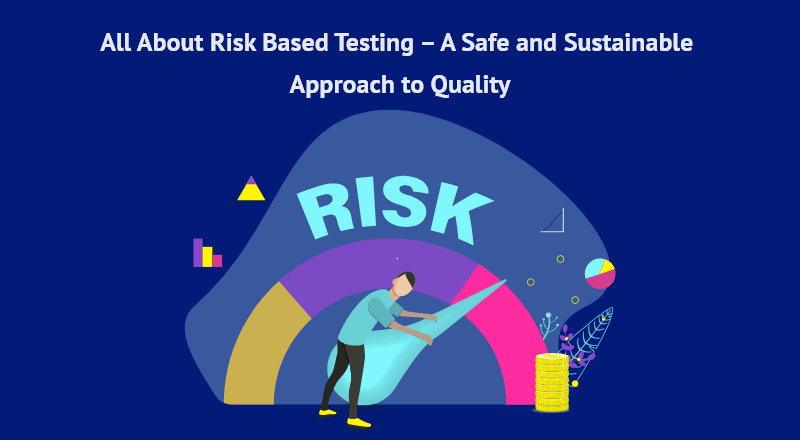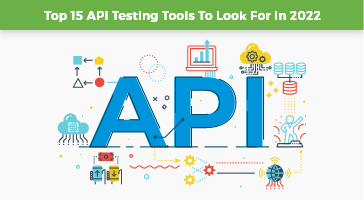
Be it any software project, there are set goals that are targeted for achievement. There is so much involved in getting a project ready on time – schedules, resources, budgets, infrastructure, and more. One thing that can hamper the timely implementation of the project is the inclusion of risks that can be of any type – internal or external, big, or small. These risks can cause havoc in the smooth functioning of the project. One solution that can protect software projects from these risks is Risk Based Testing.
When we say ‘risk’, it means the happening of an unclear activity that can cause harm to the project. It can have a great impact on different parameters like budget, quality, implementation, customer satisfaction, etc.
Gone is the time when testing was introduced once the entire project is ready. Today’s modernized way of software development looks at testing as an integral component of the entire software development cycle. Testing is now done at each development stage of the project, attempting to remove errors as soon as it is encountered. On a similar note, risk-based testing can be of great help if introduced at the right time at the right place.
Risk-Based Testing – An Introduction
Risk-based testing (RBT) is a type of software testing that functions as an organizational principle used to prioritize the tests of features and functions in software, based on the risk of failure, the function of their importance, and likelihood or impact of failure. – Wikipedia
Risk-based testing (RBT) is a type of testing that is dependent upon the chances of risk occurrence. It considers those factors and features of the project that could have a direct impact on the project. There are different parameters that are considered – criticality of features, the complication of events, rate of occurrence, etc. The fundamental objectives of RBT are to:
- Design and execute testing events that involve the highest business risk
- Smoothen customer implementation process not to let risks hamper it
- Find out possible risks or failures way ahead of time to prevent it from occurrence
- Avoid the impact of risks on organizational deadlines, costs, and business prospects
- Help in implementing agile and DevOps processes smoothly
- Ensure a quality rich and error-free software for clients
Effective risk-based testing does not mean that there will be no risk involved in the project. That is too optimistic to ask for. What it implies is attempting to minimize all risks that can hamper project parameters and achieve a smooth run. Here risks involved could be product risks, project risks, and process risks. They could also be classified as business risks, non-business risks or financial risks.
Risk based testing could involve, technical testing – environment/integration testing, functional testing – features/modules/functionalities/programs, and non-functional testing – load/performance/configuration/security testing.
Some of the key metrics that are required for performing risk-based testing are – planned vs executed test cases, number of critical open risks, test coverage report, percentage of risk identification/mitigation/leakage, test summary report, schedules vs actual efforts.
Key Advantages of Risk-based Testing
- There is increased user focus that will directly offer more customer satisfaction, business performance, and better quality of work
- High-risk areas are identified well on time, leading to the least havoc in projects at actual implementation time
- It offers a better testing coverage, identifying specific areas to be tested, how and when to start, and finding out the impact of the risks
- The overall software quality is bound to enhance since all possible risks are well tested and hence all functionalities now can reach customer expectations
- There is better-structured testing with a well-defined scope of work, deadlines, priorities, test cases, test data, and latest testing tools involved
- It offers enhanced productivity, cost reduction, service performance, market opportunity, and go-to-market time
When to Implement This Type of Testing?
Risk based testing can be implemented when
- Projects have a limited time schedule, budget, resource allocation, etc.
- There is an implementation of incremental, iterative, agile, and DevOps project methodologies
- New projects have high-risk factors involved like new technologies, lack of skilled resources, insufficient planning etc.
- There is the involvement of cloud-based services or the latest project approaches
- The project is research-oriented or more complex with challenges
Risk-Based Testing Methodologies and Roadmap
Risk Identification
Identifying risks can be worked upon via risk checklists, workshops, interviews, brainstorming sessions, root cause analysis, etc. Risks can be identified along with possible responses. Spreadsheets can be worked out for effective monitoring and tracking. A risk breakdown structure can be constructed that can identify the risk-prone zones and thereby, evaluate the risks involved. It assists in offering a lot of time and resources for such activities.
A risk assessment matrix can be created that offers the teams a fast look at the risks and involved occurrence levels. Risks could be occurring at different levels – frequent, probable, occasional, remote, improbable. Based on this, further courses of action and priorities can be defined.
Even the severity of risks is vital for decision making – severe, high, medium, low. The degree to which harm is caused due to the risks is important for finding out which risks must be addressed to and when. Risks could be having harsh consequences, could be critical, marginal, or negligible.
Risk Analysis, Mitigation and Contingency
Analyzing risk is important and based on that, it must be decided how best to respond to that risk. Some risks may need a quick response, some can wait. This can be done through a risk matrix through which the impact and probability of the risks can be understood, and relevant actions can be taken.
Mitigating risks is also equally important since that helps in decreasing the effect of the possible risks. It can be addressed to by lowering the chances of its occurrence or at least get it down to a bearable level.
Even a back plan or a contingency plan must be kept ready through which any type of impulsive risk can be attended. It refers to a happening that is not sure of, and its effect is also not known. Basically, the contingency plan is to cater to the risks that are uncertain and could turn out to be harmful to the project.
Risk Response Planning
Once the analysis is done, stakeholders come to know if the risk needs a response or not. Some risks may need a response while planning of the project, some may need it while testing and monitoring projects. Some would be so negligible that they may not need a response at all. This phase of risk-based testing is important to bring out the major risks and attend to them all instead of wasting time over miniscule risks.
Risk Monitoring and Control
However much you try, some risks are bound to occur. At such time, charting out a proper monitoring and control mechanism is a must. It helps in identifying risks, monitoring them, finding out new ones, analyzing the basic reasons for their occurrence, implementing the risk plans, and keeping an eye on its metrics. Various types of assessments, audits, trend analysis, performance measurement, status updates form a part of this methodology. It also depends upon different parameters that are involved in the projects like technology updates, size of the project, number and skills of resources, time, and effort estimation, and many more.
Risk Based System Testing
RBT includes a system-level of testing that is formed by technical, functional, and non-functional system test. It comprises environmental testing, integration testing, feature level testing, load testing, stress testing, security testing, etc. A system-level testing approach is a must since that forms the core of any system and is hence highly recommended.
Best Practices for a Smooth Risk-Based Testing
In general, the different activities involved while performing risk-based testing involve the following steps, except for certain specific situations:
- Prepare a detailed list of risks that could be involved through checklists, interviews, workshops, root cause analysis, expert opinions, etc.
- Register all risks with possible reasons, responses, and root causes
- Prepare test cases, test documentation, test data involving each risk
- Map test coverage with risk assessments to ensure all risks are covered in the test documents
- Keep accommodating newer risks as the project progresses
- Perform quantitative and qualitative risk analysis with a risk matrix
- Decide if risks need a response or not
- Mitigate risks as far as possible
- Keep a contingency plan ready for backup in worst cases
- Have a proper monitoring and control mechanism ready through different risk audits, assessments, trend analysis, status meetings, etc.
- Collaborate with different management and development teams for understanding the risks better
- Have proper communication with the team and keep changing risks assessment plans accordingly so that any change in project activities can be embedded in risk management
- Keep updating the test coverage plan according to updates in the project
Some of the Key Test Reports and Metrics That Prove Crucial for RBT
- Number of test cases – planned vs actual
- Number of defects, priority wise, status wise
- Test summary/coverage report
- Risk mitigation efficiency
- Requirement stability index
- Test effectiveness
- Test design coverage
- Defect detection efficiency
- Environmental Failures
And many more…
On a Parting Note
Risk-based testing is now one of the most important and smart testing strategies in software testing services. Organizations are now giving it due importance and enjoying successful and secure outputs. As projects are getting complicated, software testing is becoming smarter and effective. Testing cannot simply be done by taking all project-related functionalities. It needs to embed the risk assessment effectively and that is what forms the crux of risk-based testing – the smart way to effective testing!



